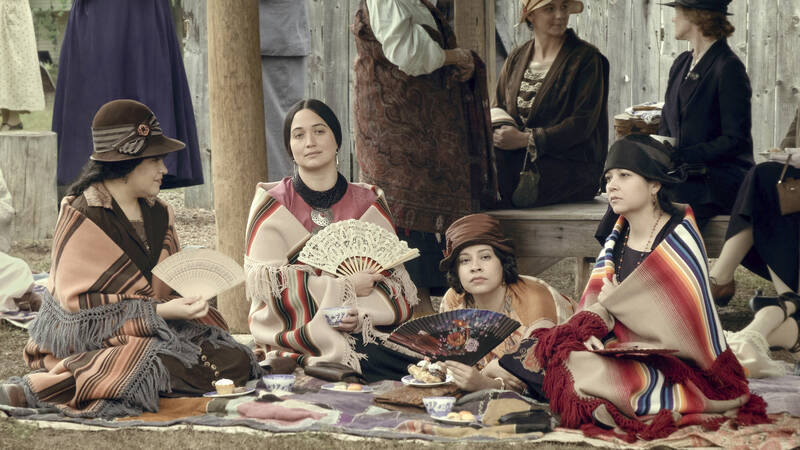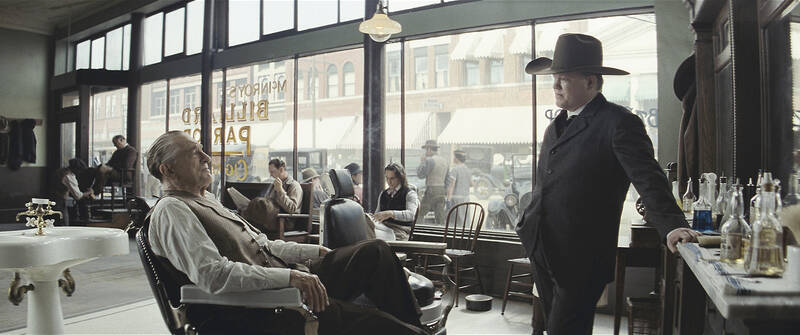As eagles swoop overhead and a cool autumnal wind blows through the cemetery in Gray Horse, on the ancient lands of the Osage people in northern Oklahoma, Margie Burkhart points to the tombs of ancestors murdered a century ago.
The tragedy that struck her family is at the heart of the new Martin Scorsese film Killers of the Flower Moon, taken from the best-selling book of the same name.
In the 1920s, Mollie Burkhart, Margie’s grandmother — played in the film by Native American actress Lily Gladstone — saw her mother, her sisters and her brother-in-law murdered.

Photos: AP
The killings came one after another — in a poisoning, in a bombing, by a bullet to the head.
“I think they systematically chose which ones to die,” 61-year-old Margie Burkhart said.
Intensifying the ordeal even further: The killings were orchestrated by Mollie’s own husband, Ernest Burkhart, played by Leonardo DiCaprio, and his uncle William Hale (Robert De Niro) — two white settlers intent on getting their hands on the Osage family’s rights to their oil-rich property.

Photos: AP
REIGN OF TERROR
Today, the yellowing fields around Gray Horse are dotted with the occasional oil rig — but this is nothing compared to the huge boom at the turn of the 20th century, when the huge machinery covered the prairies for miles around. That’s when one of the most prolific oil fields in the US at the time was discovered on the Osage reservation.
The Osage people held the exclusive rights to exploiting this underground wealth — rights that legally could only be transferred to or inherited by an Osage member’s legal heir.
“The Osages were considered the wealthiest people in the world,” said Kathryn Red Corn, who is Osage, speaking in a house built by her great-grandfather in Pawhuska, the seat of the Osage nation’s current government. That wealth drew the attention of some nefarious white settlers.
People came to the area and wooed and married members of the Osage nation for their money, the 82-year-old Red Corn said. “They would have them murdered, and then they would inherit what they had,” she said. The walls of her living room are decorated with Osage art and black-and-white photos of her ancestors.
In all, at least 60 members of the Osage nation — many more by some estimates — were believed murdered during a period that became known as the Reign of Terror.
SUSPICIOUS POISONING
Red Corn’s grandfather, Raymond Red Corn Sr., who was also Osage, suspected his second wife, a white woman, of poisoning him. He died suddenly in his 40s and in otherwise good health, Kathryn Red Corn said. His death, in the early 1920s, was never investigated.
For Margie Burkhart, the sense of anger and suffering around these murders are still palpable — feelings reawakened this summer when she attended a private screening of Scorsese’s film.
“They took away my (great-)aunties, and I could have had a big family,” she said, almost choking on the words. “I could have had a lot of cousins, nieces, nephews — and I grew up without them.”
She added: “William Hale didn’t have to do that,” she said of one of the masterminds of the killings. “He was one of the richest people in Osage County.”
“It was just for greed. He wanted more money.”
NO JUSTICE
“Simply because they were Indian, their life had lesser value,” lamented 62-year-old Jim Gray, a former principal chief of the Osage nation.
He said his great-grandfather Henry Roan was murdered in 1923, also in a plot organized by Hale, who had taken out a life insurance policy in Roan’s name. Both Ernest Burkhart and Hale were eventually convicted of murder — despite their efforts at a cover-up — and received life sentences.
Gray said only a small percentage of the Osage murders in this period were investigated by federal authorities.
“These stories have not been told,” he said in the small town of Skiatook, north of Tulsa. “There’s been no justice for those families.”
Gray was deeply concerned when he heard that Hollywood had taken an interest in this painful chapter of Osage history. “Were we just going to be second-tier characters in our own story?” he wondered.
Instead, Gray said, “Imagine our surprise when Scorsese reached out and met with us, and listened to us and effectively rewrote big portions of the script.”
Having originally focused on the federal investigation, writers reworked the script to center on the story of Mollie and Ernest Burkhart.
“You’re going to watch this film and the Osage influence, you’re going to be able to feel it,” Gray said. He hopes the film’s release tomorrow will spark debate about “the people that were stepped on” to make the country “what it is today.” Gray added: “People may not want to talk about it. It’s not in our history books.”
But, he went on, “We need to know our past, especially the mistakes ... so that we won’t repeat them.”
Margie Burkhart also hopes the film keeps memories of the Osage’s searing trauma from dimming into oblivion.
“In two, three years from now, when the movie fades away, I hope people are still talking about it,” she said.

June 23 to June 29 After capturing the walled city of Hsinchu on June 22, 1895, the Japanese hoped to quickly push south and seize control of Taiwan’s entire west coast — but their advance was stalled for more than a month. Not only did local Hakka fighters continue to cause them headaches, resistance forces even attempted to retake the city three times. “We had planned to occupy Anping (Tainan) and Takao (Kaohsiung) as soon as possible, but ever since we took Hsinchu, nearby bandits proclaiming to be ‘righteous people’ (義民) have been destroying train tracks and electrical cables, and gathering in villages

Dr. Y. Tony Yang, Associate Dean of Health Policy and Population Science at George Washington University, argued last week in a piece for the Taipei Times about former president Ma Ying-jeou (馬英九) leading a student delegation to the People’s Republic of China (PRC) that, “The real question is not whether Ma’s visit helps or hurts Taiwan — it is why Taiwan lacks a sophisticated, multi-track approach to one of the most complex geopolitical relationships in the world” (“Ma’s Visit, DPP’s Blind Spot,” June 18, page 8). Yang contends that the Democratic Progressive Party (DPP) has a blind spot: “By treating any

Swooping low over the banks of a Nile River tributary, an aid flight run by retired American military officers released a stream of food-stuffed sacks over a town emptied by fighting in South Sudan, a country wracked by conflict. Last week’s air drop was the latest in a controversial development — private contracting firms led by former US intelligence officers and military veterans delivering aid to some of the world’s deadliest conflict zones, in operations organized with governments that are combatants in the conflicts. The moves are roiling the global aid community, which warns of a more militarized, politicized and profit-seeking trend

This year will go down in the history books. Taiwan faces enormous turmoil and uncertainty in the coming months. Which political parties are in a good position to handle big changes? All of the main parties are beset with challenges. Taking stock, this column examined the Taiwan People’s Party (TPP) (“Huang Kuo-chang’s choking the life out of the TPP,” May 28, page 12), the Democratic Progressive Party (DPP) (“Challenges amid choppy waters for the DPP,” June 14, page 12) and the Chinese Nationalist Party (KMT) (“KMT struggles to seize opportunities as ‘interesting times’ loom,” June 20, page 11). Times like these can